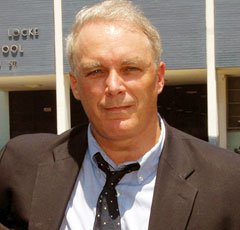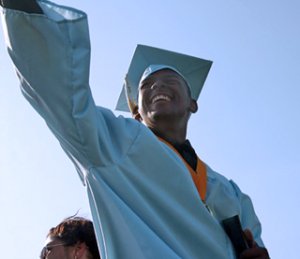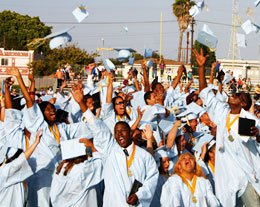Steve Barr’s Answers for School Reform
Green Dot’s founder, who led the turnaround of the toughest school in Los Angeles, discusses his ideas on how to fix a failing system.

This might be the moment for Green Dot founder Steve Barr.
The Obama administration has set a goal of turning around 5,000 failing schools in the next five years, supported by an expected $3 billion in stimulus funds and $2 billion in the 2009 and 2010 budgets. Known in education circles and beyond as an aggressive agent of change, Barr has been in talks with Secretary of Education Arne Duncan about how to boost failing schools and whether Green Dot's methods can serve as a blueprint for fixing schools across the country.
It was these same failing schools that inspired Barr to start Green Dot. Having known hard times in his youth, including some time as a foster child, Barr was drawn to improving schools for disenfranchised youth.
After working in politics for many years (and cofounding Rock the Vote), he began researching the push to wire all schools with technology. He saw a map that used green dots to represent schools with the necessary infrastructure to be wired and red dots for schools that lacked that foundation. Barr had the vision that every school should be a green dot, and thus began his crusade.
Green Dot consists of 19 small charter high schools in Los Angeles -- several of which were formerly part of Watts's infamous Locke High School, which Green Dot, in an unprecedented coup, broke down into smaller schools. In addition, Green Dot New York finished its first year last June.
We caught up with Barr at his office in downtown Los Angeles.
Do you think Green Dot may go national in trying to replicate its success?
The mission of Green Dot from day one was to create systemic change, not to create a bunch of charter schools. Originally, the idea was to concentrate on the second-biggest school district in the country, in Los Angeles. If we could make a dent in one district, it would have more effect nationally than me flying around and creating little charter schools everywhere.
We go in areas where there are high dropout rates. We take the same kids and the same dollars designated for each student, and we retain and graduate 80-90 percent of those seniors, with about 65-75 percent of those kids going on to four-year colleges. So that can be interpreted as a reversal of the achievement gap in those communities.

We're listening -- and we're not there yet. The initial thought we had is, if you can create one turnaround model in Los Angeles and maybe one on the East Coast, that, in turn, creates a turnaround institute, and other people in other cities can come and learn just how you do it.
I've known Arne Duncan from the time he asked us to come take over a few schools in Chicago. When he became secretary of education, they passed that breathtaking amount of investment -- $100 billion in public education, which is the biggest investment since World War II.
Even though we weren't looking to go national at that time, because we were really concentrating on the takeover of Locke High School, that just got very interesting in a hurry. One of the foundations of it is going to be turning around failed schools, the bottom 5 percent.
How does that turnaround happen? What happens in the classroom that makes for the kind of phenomenal numbers you've achieved in Los Angeles?
A lot of political and systemic change needs to happen. For instance, in our second school, Ánimo Inglewood Charter High School, opened in 2002, we tested all the kids coming into that ninth-grade class in the summer, and it was dismal. They couldn't read. Half the kids were somewhere between first- and third-grade reading level coming into high school, which means for eight years, they've been in heavy neglect. And their math, there wasn't even a pulse.
We assembled a bunch of reading experts, people who really have done it before. The teachers picked this program, Read 180, from Scholastic. The biggest reason we picked that program is that we were heavily focused on technology, and that intervention used a lot of our laptops.
How did the students respond?
The kids are 14 years old. They can't read. With kids who can't read and have been beaten down, you can see it as they walk around at the beginning of the school year. They don't feel confident enough to even look you in the eye. Their light is barely on.
So they go to regular English class, and then they go to a double-up English class if they are under a certain level. It's pretty simple: If a kid reads three hours a day, he's going to learn how to read. So these kids read every day.
And usually by Halloween or the first break, they start standing up straight, their chests begin coming out, and they start looking at you in the eye, because they're getting turned on academically, and adults know their name, and they're getting help for the first time. By the spring break, these kids are world beaters.
World beaters?
Yeah, I mean revolutionaries. I mean ánimo, which is Spanish for "courage" -- or my surfer friend's translation, "get off your ass." I mean their confidence. A 14-year-old kid who learns how to read for the first time? Everything else gets easier after that. Because now you've created a monster, and they really want to learn. And they stop thinking, as they've been told for all their time in the public education system, that they are second class or second rate or dumb. No, they're smart, and we nurture that.
Now, at another school, Ánimo Pat Brown, where they had 1 percent proficiency in math, the teachers came to us and said, "We want to try something bold and different to reach these kids." I said, "OK. What do you want to do?" They answered, "We want to integrate math in all subjects." That sounds cool. Every subject is going to have that same math lesson through the day.
And they said, "We want to scrap ninth-grade biology and go right to physics, because 60 percent of physics is algebra." I said, "OK." So what happened in that first year -- 2006-07 -- is, they went up to 46 percent proficiency in math. What is the lesson of both those stories? We listened to the teachers. We allowed them to lead. We supported them.

What do you think about the criticism that charter schools leave kids behind and drain some of the will to improve big public schools?
Well, what's the alternative? You spread out a few smart people around a bunch of failure until they get discouraged and leave, until they get burnt out and get tired of raging against a machine that can't be changed?
Think about the masses of really smart people who would love to teach if you fixed the working conditions. How do you actually fix that? You create an alternative culture and prove that you can have a different model that works, and then, in turn, more people will come into the profession if you fix that system. What we're really talking about here is leadership and system change.
We went through this at Locke. There were a handful of teachers there who were Teach for America grads. They fit that crusader prototype -- brilliant, determined, passionate. But they were fed up. They were looking for some way to change the system. So they talked about a charter school.
I said, "We're talking to the school district, and there's a chance to transform some public schools and some high schools. And I know I don't have the right to tell you to be patient, but try to be, because I don't want to pull the best teachers out of this school to create a charter school."
Well, nothing changed. The school district balked. It didn't want our help. And then, after two or three years, those teachers just said, "OK, we're starting a school." And they went and started a charter school in South Central Los Angeles: Ánimo Pat Brown.
What's the take-away from that?
They were being held back. And if we hadn't come along and given them a school, those people would have left the system. What a shame for the system, but also what a shame for the students who would never have gotten the opportunity to learn from the teachers.
So I think Locke is a game changer, because Locke, unlike other charter schools, didn't take a select group of students. Green Dot adopted the existing student body and changed a significant amount of the school's staff. People can't simply explain away the results of a school like that.
That school's going to get better and better, and people from the city, even people in affluent neighborhoods like where I live, are going to look at that and say, "I want a school like that. If they can do that there, why can't they do it in my neighborhood? I'd like my kids to go to a 500-student high school with high expectations and where most of the kids go to college. I'll pay more taxes for that."
Yet Locke High School was a very dangerous place up until last year.
That school is at the intersection of several gang territories. The Crips and the Bloods were founded within blocks of that school, and they owned it. The adults were not in charge of that school last year, and I'm not exaggerating. It's been called a tax-subsidized gang-recruitment center, not a high school. You could buy drugs. You could buy sex. You could do anything you wanted in that school.
And if you were an adult who spoke up, you got beat down. There was a riot there a year ago because two kids got in a fight and there were no adults around. It went on for half an hour, and 60 kids got in the fight. Finally, a principal poked out his head and called the police and reported a riot. Every cop was dispensed there, but it was really just a fight between two kids, which happens in any high school; it's just that there were no adults.
So, how did you break through?
We went and sold the community on the idea that we were going to change it, because with every neighborhood we've served, we've realized that gang members don't want their kids to repeat their life. It's not lucrative. It's not safe, and you don't want to see your children go through that. So, you've got to sell the gang neighborhood on it.
We hired a lot of security and pushed the gangs off. Anything you do two blocks away from this school, it's not our business. But this school and the blocks that immediately surround it are our business.
Because if the school's not safe, you can't do any of the other stuff I'm talking about. You can't do reading interventions or math interventions or AP classes. The other thing we did is collaborate with the stakeholders in that neighborhood, which comes from organizing.
Organizing parents is something that seems unique about the work you're doing. People say that in essence, you are an organizer.
I was raised very much like a lot of the kids we serve -- very poor, very looked down on. I wasn't a minority, but I was looked down on by peers and by the institutions I went to. And I saw my mom humiliated a lot during that process. So, I have a finely tuned chip on my shoulder. And I think you see some of that in Green Dot.
If you're going to turn around the kids who are new to this country or have been in bad school systems, the fastest way is to get the family to buy in, too, and not stigmatize the family just because they maybe didn't get out of the eighth grade.
Our first school, Ánimo Leadership, was a 98 percent Latino school in Lennox, one of the poorest areas of Los Angeles County. An assistant principal at the middle school said to me, "If you offer a partnership to these families, they'll treat your school like religion. They will work their tails off for it."
And so, at that first school, I had this amazing family -- not an actual family, but the family community of that neighborhood -- pulling with me.
When you create that kind of respect and relationship, it becomes part of the culture of the school. Once you have that, you've got the parents. And if you're true to them based on that beginning relationship, that's how you transform a school.